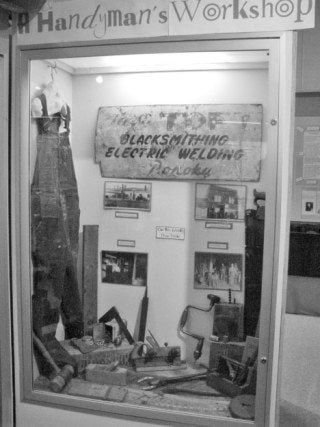Thousands of colourful government pamphlets were sent out at the beginning and on into the vibrant 19th century to encourage families and individuals from throughout North America and overseas to come and settle on the vast and bountiful Canadian prairies. As well as explaining the countless opportunities and fabulous land prices this energetic promotion also urged handymen to bring along their toolboxes and unique skills to help assure instant employment and success.
As farms and businesses were quickly established in busy villages and districts there would be a huge demand for trained or self-taught carpenters, blacksmiths, machinists, shipwrights, cabinet makers, seamstresses, millwrights, farm hands, leather workers, couch makers, tailors, wheelwrights, and on and on. Together in just a few short years their skills and determination would help to build a nation, and to provide the facilities and expertise that would encourage the professionals and businesses that would serve all facets and hardy new members of those growing communities.
History tells us that woodworking, craftsmanship, and simple trades likely started way back in 8000 B.C. by means of primitive pounding and punching tools and axes that were made out of wood, stone, and bones. Ambitious and inventive men and women quickly took up the cause and came up with improved tools and appliances, that along with hard work and will power would help to achieve most of the requirements of early survival and the harsh living conditions on the prairies.
In time, special axes and hammers were fashioned out of wood and steel to neatly cut-peel-notch and square the massive logs that would become our first stores, barns, churches, schools, and quaint but very sturdy homes. Other tools quickly making their appearance included all sorts of hammers and saws made of wood and fine Sheffield steel or brass, finishing and smoothing plains, drills, steel nails that were made for each task and bent on an anvil, measuring squares, awls, a horse tail docker, and much-more to compliment the new building materials and ideas that were being introduced each and very day to the new settlers.
Ponoka progress was quick and exciting
In the midst of all the development in all directions Ponoka would become a town in 1904, and as the construction boom took hold, several local sawmills were providing up to 20,000 board feet of lumber a day to keep up with the demand. Early log cabins were likely a 16 by 22 feet structure, built 1-½ stories high, and accommodating a family of up to 16 members.
In April 1901 there were three blacksmith shops in Ponoka to handle the busy care and repair requirements of the horse and buggy era. Peter Horn was probably our first blacksmith, and it was said that he rode horseback or walked the four miles into town each day to practise his trade. Other early skilled blacksmiths who worked the area included: Fred Paul, George Starkey, Mr. Heckither, John Stewart. Edward Bright, Martin Bednar, Clarence Carson, and O. B. Knipfel; the latter a real character who was also a fine musician and leader of the Town band! Tommy Cooper, a single man came to Ponoka in 1915 and worked in George and Pete Horn’s new blacksmith shop. He later married, and while his wife and son Tom ran one of the most popular ice cream and confectionery shops in town, he would faithfully carry on his blacksmith trade until 1949 when the mechanical age was in full swing.
Herb Rees, a marine engineer, built the first machine shop in the south end of Ponoka in 1912. His extreme skills were in great demand, assisting with the building of the asylum, but always finding time for his favourite hobbies of building clocks and toy steam engines, as well as a vintage World War 1 cannon to commemorate the end of the war in 1918, and sat next to the C.P.R. station for many decades. Other prominent welders and machinists in the area were the Russian Mr. Bressuilik in 1929, Herb Rees, Mr. Jackson, Percy King, Johnnie Walton, Al Nelson, Guy Newton, and Mike Prediger; who later became on of Ponoka’s most popular barbers. Theodore Toft came to town in the 1940s to set up a very business offering blacksmithing, lathe work, and welding; later purchasing one of the first electric welders. Here are just a few more colourful highlights of the early tradesmen of Ponoka and districts, and there were many; as well as the odd cattle rustler, village Casanovas, and a great many wonderful characters of our colourful past.
*Percy Odell built a small tractor from an Austin car and drove it back and forth to work, 8 miles, every day.
*Charlie ‘wrecker’ Johnson purchased a Model ‘T’ from Tom Hickmore, cut the motor in half, patched and welded the block, attached a governor, and had a nifty two cylinder Ford power plant for his shop.
*Henry Taylor had a long-standing reputation of being able to repair anything that was broke.
* Tommy Cooper was a fine blacksmith who could shoe horses, force weld, set wagon tires, and tell great stories to whoever would listen!
Many of these fascinating stories and treasures about the people and events of the history of our town and districts can be seen at the Fort Ostell Museum or found in books such as:
The Ponoka Panorama, Mecca Glen Memories, Crestomere/Sylvan Heights Heritage and others; available at your local Jubilee Library.
